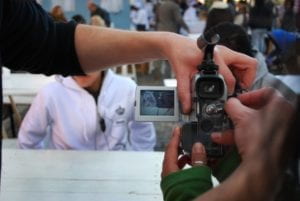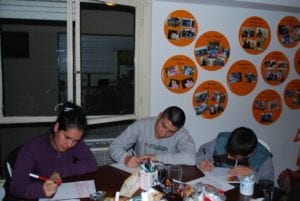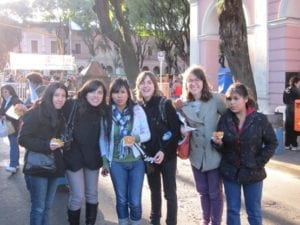Alexandra Kamler
Antigua, Guatemala
Last time I wrote, I had just sent the director of INVAL, Magali Rosales Garcia the sexual health curriculum that Alex, Andrea, and I had created for the students. On Monday I sent it, on Tuesday I followed up, and on Wednesday when I had yet to hear anything, we went to INVAL to speak with the director. It seems much easier to just walk in and ask to speak with a director of a high school here than it would be in the United States. Appointments do not seem as necessary and email correspondence has not proven to be the best method of communication. Showing up seems to work best. Magali apologized for not returning our emails; she was swamped with restructuring classes. Four of her teachers were suspended. INVAL is a public school, funded by the government. Classes are separated in two parts, the morning classes, and afternoon classes. Students either attend classes in the morning or afternoon. There are 16 sections of students that attend morning classes. There are between 25 and 50 students in each class. Each day the students attending the morning classes have 8 classes of 35 minutes each. They start their days at 7:30 and end at 12:30. Magali told us that she had 4 teachers suspended; there are 4 class slots where she does not have anything for her students to do. There are not sufficient resources or number of teachers to fill the slots. How perfect we just happened to want to do a project.
After glancing over the curriculum, Magali informed us that none of this information would be new to her students but she didn’t see any reason why we should not do this project. She told us that APROFAM had already visited the students and given them workshops on sexual health and so we should not go into the classroom thinking the students were ignorant about this information or that they were ill informed. Rather, they were already well educated on all of these topics. Magali finished the meeting letting us know that our first class would be the following morning at 7:30 a.m. and we would be teaching students between the ages of 11 and 18. She also mentioned we should be teaching all the students the same information but to make sure it is age appropriate. Sure, not a problem Director.
On Thursday Alex, Andrea, and I arrived at 6:45 a.m. with two huge water jugs full of smoothies, 300 ham and cheese sandwiches, and 15 bags of cookies. That day we taught straight from 7:30 through 12:30 and saw 4 different classes, each for 2 sections of 35 minutes each. Our first class with each section starts slow as we do an activity to get to know each other and then move on to go through the parts and functions of the reproductive systems of males and females. We go over the changes that occur during puberty, giving particular attention to what happens during menstruation, and then we move on to how a woman gets pregnant and an activity that has to do with common myths regarding pregnancy prevention. We have a question box where each student is requested to write something to put in the box. It is anonymous and if we have time, we read through and answer the questions. If our time is up, we write up responses that night and print out sheets for the students to take the next day.
To the director’s surprise, the students are not as well informed as she had once thought. I remember first having sexual health classes in the third grade, then again in the sixth and in my high school, we had a human development class. I am still learning all there is about sexual health so it is understandable that the students do not remember every detail from the 15-minute presentation by APROFAM (Association for the well-being of the family in Guatemala) they had once last year. Some say that a person has to learn something six times before they really grasp onto the information.
The students engage with us and seem extremely open to the information that we are presenting. All the students have a lot of questions, apart from the 13-year-old boys who look more like seven-year-old boys and sit in silence for the first twenty minutes of the class with eyes wide and mouths open as we go over the anatomically correct pictures of the female and male reproductive systems. The students seem to have heard many popular phrases or names of diseases and myths from friends, family, and the media but are not exactly sure what they all mean when asked about them later on. We joke and cover the information, answering questions along the way hoping to clarify the different options students have in regards to protecting themselves if they choose to have sexual relationships. We pass out snacks and ask them to call us by our first names, hoping to make it a more informal and comfortable atmosphere. As the students file out of the door to say goodbye, kissing us on the cheek, one student stays behind and then another. The first asks me what the likelihood is that he has HIV if his mother has something called AIDS. He remembered us talking about the relationship between the two earlier in class and wants to know more. Another girl lags behind and waits for me to finish answering his questions before she asks me how she can give herself an abortion.
And suddenly the class is no longer as light-hearted. It has stopped being a lesson of hypothetical situations and theoretical ways in which to care for yourself. I am teaching sexual health education in a catholic country where abortion is illegal and condoms are not easily accessible, particularly for adolescents who feel ashamed to go in and ask the pharmacist who just so happens to know everyone in their community. These kids attend a school where the teachers are no shows and where I can have them for another 35-minute section if we have more information to cover. No, no math today- more sexual health education, the math teacher is sick. Apparently, the kids that attend this school are lucky to be there and most likely will start working after they graduate. Their families do not have the funds to pay for the 2 years of specialized school that comes after colegio and before the University. Many factors are just collapsing onto each other. It suddenly seems ironic that I am trying to teach these students how to care for themselves in a school that does not have potable water for them to drink. The government also thought that a good budget cut was toilet paper so for the 13 year old girl who just got her period, she better hope that her friends brought packets with them for her to use. When Alex and I walk around the school we see more people working in the office than in the classrooms and I wonder what is going on. INVAL is apparently one of the largest public institutes for kids in Guatemala. Since our teaching started, I have learned that looking at health, as a human right is necessary, particularly in finding ways to have information regarding health accessible to young people. I also think that as important as I believe sexual health to be in promoting and providing information so students can choose the options they feel are best for their own lives, there are many foundational aspects that need to be looked at in regards to health in this high school before we get to condoms and spermicide. For example, there needs to be soap in the bathroom, toilet paper, and drinking water. When I think of NYU these are the very basic items that the school supplies. But on the other hand, these students are lucky in the grander scheme of things. They get to attend school. They are not working in the dump where landslides kill people after heavy rains and vulture’s circles high above. These kids do not have to clothe every part of their body to shield it from the sun; sunglasses to protect their eyes from particles of trash, bandanas over their nose and mouth so they do not breath in the feces wrapped in toilet paper. The kids in INVAL most likely have at least one family member and can afford to not work in the morning. So relatively speaking in relation to the other children their age, who are only an hour bus ride away working in the dump, the students of INVAL are lucky to get anything. However, this is obviously problematic. This is exactly the mentality that permits a government to get away with not paying its teachers, which in turn makes them not want to show up which clearly affects the quality of education that the students receive. I am learning a lot about the students and even more about the interconnectedness of the government, economy, education, and health of the people of Guatemala. I am trying to unpack it all, understand how the different parts function, and depend on one another more clearly. And until the suspended teachers return to teach, Alex, Andrea, and I will be at INVAL learning and answering questions from the ‘anonymous questions box.’.


